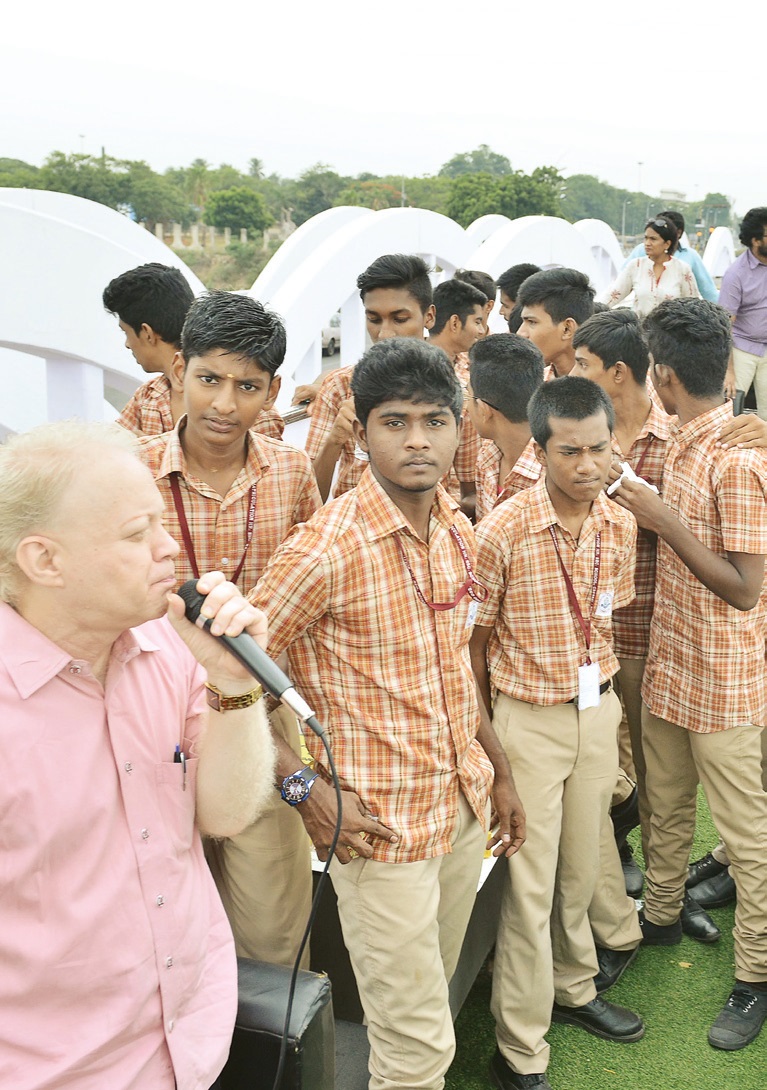Chennai :
A long with over a dozen students from Beta Matriculation School, we board the Chennai Express – TNIE’s double-decker bus (sponsored by NAC Jewellers) near the famous Gandhi statue. The youngsters were eager to learn more about the history of the city, and were surprised when Suresh Sethuraman, convener of INTACH Chennai Chapter joined us.
Suresh, a numismatic expert and one of the very few with a doctorate in this field, has written over 30 books. Cheerfully greeting the students, he began talking about the heritage buildings along the Rajaji Salai – Wallajah Road stretch.

“The DGP office to your left was built in 1839, and the Queen Mary’s College in 1914 was the first women’s college in South India…,” were some of the interesting nuggets he announced on the mike. As we cross several other buildings on the stretch, including the Ice House (Vivekanandar Illam), Presidency College and the University of Madras, Suresh quizzes the students. “Why was the ‘Ice House’ called so?” Pat came the reply from a 15-year-old, “The British imported ice from America and stored it here,” and Suresh continued, “Yes, from Boston! And the ice crossed the equator twice and never melted!” he added.
Across the Napier Bridge, we reach the War Memorial and take a detour via the railway office building and notice a few more heritage buildings like the Curzons. “It was built in the early 20th Century and they are wonderful furniture makers. In fact, they made the furniture for the Madras University library,” shared Suresh.
After a satisfying tour, we caught up with Suresh for a small chat about being an archaeologist. “Archaeology has always been a rare subject. But now it’s getting rarer,” he explained. “People are not taking to it due to two main reasons — lack of awareness about the subject and the wrong notion that archaeologists have to live in the forest digging and can’t make money. Senior archaeologists are retiring and we don’t have youngsters with technical qualifications to occupy the post. So, we are trying to spread awareness through career counselling sessions.”
Though foreign governments are giving scholarships to Indian nationals to hone their skills in archaeology, Suresh rued that the number of eligible applicants is few. “This is why engineers and doctors corner the scholarships. We don’t have good archeologists who apply for them!” he said, and added that heritage clubs in schools and colleges could be used to create awareness among the youth. “You can graduate in any discipline and pursue a masters in archaeology,” he said. The oldest teaching institution for archaeology in India is the University of Madras, while Deccan College, Pune and MS University, Vadodara are colleges that match international standards. “Sadly, we don’t have many Indian students studying the subject in these universities. But, people from abroad come here to study. That’s the sad state,” he sighed.
Scholars have pointed out that before 1947, Santhome, Kilpauk and Chetpet were sites of archaeological digs. “There’s a lot of scope for excavations in Chennai. The irony is that India is rich in archaeology but poor in archeologists,” he averred.
Suresh explained about a little-known piece of history — Roman trade in South India. “Romans and Greeks came here 2,000 years ago. They reached Poduke (Arikamedu) and came to Pondicherry. From there they travelled to Melange (Mahabalipuram) and finally reached Mailarfa (Mylapore). They used the ECR route even before we built it!” The Romans took Indian textiles, gems and spices for gold and silver coins and accidental discoveries have shown that their presence was strong in areas like Mambalam and Saidapet. “Excavation is still on in some rural parts like Kodumanal,” he said.
But the most astonishing fact is that scholars and archaeologists from abroad aren’t aware of the Roman trade in South India. “It’s our fault too. We discover something but we don’t publish it in international journals. Even in books about Romans, the trade is either mentioned in merely a line or there’s no reference at all,” he rued.
source: http://www.newindianexpress.com / The New Indian Express / Home> Cities> Chennai / by Roshne B / August 29th, 2016